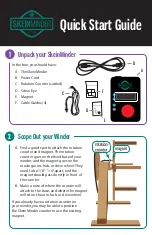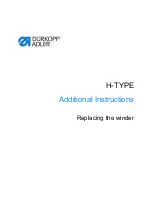
inStructionS For eLaStic Foot:
1. Before attaching the elastic foot to the machine, loosen
the elastic pressure adjustment screw, raise the pressure
plate and insert the elastic until it reaches behind the foot
(see illustration). Tighten the elastic pressure adjustment
screw slightly.
note: The lines on the screw are for elastic tension
reference on future projects.
2. Replace the standard foot on the machine with the elastic
foot and elastic.
3. While stitching elastic onto your test fabric, adjust the
elastic pressure adjustment screw until the desired effect
is achieved.
note: To insert elastic while elastic foot is on machine,
raise presser foot. Loosen elastic pressure adjustment screw,
raise the pressure plate and insert elastic until it touches the
needle. Stitch until the elastic passes the needle. Position
fabric and then adjust pressure screw as needed.
Elastic Pressure Adjustment Screw
Confidently serge elastic by letting this foot take care of all the
work. This foot provides even tension on the elastic every time
to prevent pulling and tugging on the needles. The adjustable
guide and tension dial allow you to serge elastic with a
finished uniform stretch. The guide holes provide control for
projects requiring fishing line.
inSerting FiShing Line uSing the eLaStic Foot:
Machine SettingS
Stitch type:
3-Thread Rolled Hem
Needle:
02
Stitch selector:
D
Stitch width:
5.0
Stitch length:
1.5R (Rolled hem setting)
Differential feed:
0.6
Upper knife:
Engaged “UNLOCKED”
Sewing speed:
Slow
1. Thread your serger for a 3-thread rolled edge using decorative
threads in the upper looper.
2. Slide the fishline through the guide holes on the right side of
the elastic foot and then under the back of the foot leaving a
3” to 4” tail in the back.
3. Snap the foot on the machine and place the fabric under the
foot with the fishline to the right of the needle.
4. Begin serging making sure the fishline is caught in the stitching
as the edge is being rolled.
5. When you have finished serging, carefully remove the fabric
and fishline from under the presser foot being careful not to
pull the fishline out of the seam.
elastic Foot
(BLe-eF)
instructions
attaching eLaStic uSing eLaStic Foot:
Machine SettingS
Stitch type:
4-Thread Overlock
Needle:
01and 02
Stitch width:
M-7.5
Stitch length:
4.0
Upper knife:
Engaged “UNLOCKED”
Differential feed: 0.5
Sewing speed:
Slow speed
1. Insert elastic into elastic foot (see instructions for elastic foot).
2. Set up machine according to above chart.
3. Slightly raise the pressure plate of the foot and insert elastic
between the plate and lower support bar until the edge of
elastic reaches the feed teeth. (It may be necessary to loosen
the elastic pressure adjustment screw to feed the elastic
through.)
4. Loosen the screw on the adjustable tape guide to
accommodate the width of your elastic, and then re-tighten
the screw.
5. Sew the elastic for about an inch or so to ensure it is feeding
properly.
6. Place the fabric under the foot and sew elastic to fabric.
7. Adjust the elastic pressure adjustment screw so that the
desired finish can be obtained.
a. Tighter tension on the elastic gives more elasticity of the
fabric after it is sewn.
b. Looser tension on the elastic gives less elasticity of the
fabric.
Machine SettingS
Stitch type:
4-thread Overlock
Differential feed setting: 2
Needle:
Both*
Sewing foot:
Ruffling foot
Upper knife:
Engaged
Needle thread tension: Normal
Stitch length:
4
Stitch width:
4.7-7.5
inSerting the FaBric LaYerS:
1. Replace the standard presser foot with the ruffling foot.
2. Raise the ruffling foot. Set the needles at the highest position.
3. Place the bottom fabric layer to be gathered (see #1 on
illustration) right side up between the needle plate and
foot, and align the fabric under the foot until it reaches the
needles. Turn the handwheel to catch the fabric with the
needles.
4. Place the top fabric (see #2 on illustration) in the opening
flush with the bottom fabric right sides together, and align
with the edge of the guide.
5. Lower the ruffling foot and sew guiding both fabric layers.
Lighter weight fabric will produce the maximum amount of
ruffles.
*You will achieve a fuller ruffle when using both needles.
Easily make and attach ruffles as well as finish your edges
in one simple step. Add perfectly spaced ruffles to garments,
pillows, and other home décor items. This ruffling foot works
on all fabric types.
ruffling Foot
(BLe-rF)
instructions
Pressure Plate
Elastic
Elastic
Fabric
Knife




















